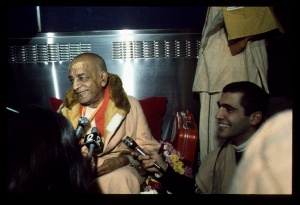CC Antya 3.149 (1975): Difference between revisions
(Vanibot #0027: CCMirror - Mirror CC's 1996 edition to form a basis for 1975) |
(Vanibot #0020: VersionCompareLinker - added a link to the Version Compare feature) |
||
| Line 2: | Line 2: | ||
<div style="float:left">'''[[Sri Caitanya-caritamrta (1975)|Śrī Caitanya-caritāmṛta (1975)]] - [[CC Antya (1975)|Antya-līlā]] - [[CC Antya 3 (1975)|Chapter 3: The Glories of Śrīla Haridāsa Ṭhākura]]'''</div> | <div style="float:left">'''[[Sri Caitanya-caritamrta (1975)|Śrī Caitanya-caritāmṛta (1975)]] - [[CC Antya (1975)|Antya-līlā]] - [[CC Antya 3 (1975)|Chapter 3: The Glories of Śrīla Haridāsa Ṭhākura]]'''</div> | ||
<div style="float:right">[[File:Go-previous.png|link=CC Antya 3.148 (1975)|Antya-līlā 3.148]] '''[[CC Antya 3.148 (1975)|Antya-līlā 3.148]] - [[CC Antya 3.150 (1975)|Antya-līlā 3.150]]''' [[File:Go-next.png|link=CC Antya 3.150 (1975)|Antya-līlā 3.150]]</div> | <div style="float:right">[[File:Go-previous.png|link=CC Antya 3.148 (1975)|Antya-līlā 3.148]] '''[[CC Antya 3.148 (1975)|Antya-līlā 3.148]] - [[CC Antya 3.150 (1975)|Antya-līlā 3.150]]''' [[File:Go-next.png|link=CC Antya 3.150 (1975)|Antya-līlā 3.150]]</div> | ||
{{CompareVersions|CC|Antya 3.149|CC 1975|CC 1996}} | |||
{{RandomImage}} | {{RandomImage}} | ||
==== TEXT 149 ==== | ==== TEXT 149 ==== | ||
| Line 25: | Line 24: | ||
<div class="translation"> | <div class="translation"> | ||
For two | For two purposes-to spread the cult of bhakti and to defeat and subdue the atheists-Lord Nityānanda, the most dedicated devotee of the Lord, moved throughout the country. | ||
</div> | </div> | ||
| Line 32: | Line 31: | ||
<div class="purport"> | <div class="purport"> | ||
As stated in | As stated in Bhagavad-gītā ([[BG 4.8 (1972)|BG 4.8]]): | ||
:paritrāṇāya sādhūnāṁ- | |||
:vināśāya ca duṣkṛtām | |||
:paritrāṇāya sādhūnāṁ vināśāya ca duṣkṛtām | dharma-saṁsthāpanārthāya | ||
:sambhavāmi yuge yuge | |||
Lord Kṛṣṇa appears in every millennium for two purposes, namely to deliver the devotees and kill the nondevotees. His devotees also have two similar purposes-to preach the bhakti cult of Kṛṣṇa consciousness and defeat all kinds of agnostics and atheistic demons. Nityānanda Prabhu carried out the order of Lord Śrī Caitanya Mahāprabhu in this way, and those who strictly follow Nityānanda Prabhu perform the same activities. There are two classes of devotees. One is called goṣṭhyānandī, and the other is called bhajanānandī. A devotee who does not preach but always engages in devotional activities is called a bhajanānandī, whereas a devotee who not only is expert in devotional service but who also preaches the cult of bhakti and defeats all kinds of agnostics is called a goṣṭhyānandī. | |||
Lord Kṛṣṇa appears in every millennium for two purposes, namely to deliver the devotees and | |||
</div> | </div> | ||
Latest revision as of 01:04, 27 January 2020

A.C. Bhaktivedanta Swami Prabhupada
TEXT 149
- prema-pracāraṇa āra pāṣaṇḍa-dalana
- dui-kārye avadhūta karena bhramaṇa
SYNONYMS
prema-pracāraṇa—preaching the cult of bhakti; āra—and; pāṣaṇḍa-dalana—subduing atheistic men; dui-kārye—with two kinds of activities; avadhūta—the great devotee and mendicant; karena—does; bhramaṇa—touring.
TRANSLATION
For two purposes-to spread the cult of bhakti and to defeat and subdue the atheists-Lord Nityānanda, the most dedicated devotee of the Lord, moved throughout the country.
PURPORT
As stated in Bhagavad-gītā (BG 4.8):
- paritrāṇāya sādhūnāṁ-
- vināśāya ca duṣkṛtām
dharma-saṁsthāpanārthāya
- sambhavāmi yuge yuge
Lord Kṛṣṇa appears in every millennium for two purposes, namely to deliver the devotees and kill the nondevotees. His devotees also have two similar purposes-to preach the bhakti cult of Kṛṣṇa consciousness and defeat all kinds of agnostics and atheistic demons. Nityānanda Prabhu carried out the order of Lord Śrī Caitanya Mahāprabhu in this way, and those who strictly follow Nityānanda Prabhu perform the same activities. There are two classes of devotees. One is called goṣṭhyānandī, and the other is called bhajanānandī. A devotee who does not preach but always engages in devotional activities is called a bhajanānandī, whereas a devotee who not only is expert in devotional service but who also preaches the cult of bhakti and defeats all kinds of agnostics is called a goṣṭhyānandī.